Stainless Steel Tubing
Stainless steel is an iron alloy that contains chromium, nickel, and other metals and elements, and has the property of being able to resist rusting, stain, and quick degradation when exposed to the elements of weather and different acids. Since there is not a strict definition of the percentages of metals that make up the alloy, there are upwards of 57 stainless steel alloys that are called stainless steels. Therefore, whenever stainless steel must be used, it is important to have a bird's eye understanding of the types, advantages, disadvantages, and accessories of stainless steel so that the chosen alloy will successfully complete the desired purpose.
Stainless steel tubing is the same metal alloy discussed above only in a tube shape. Stainless steel tubing is manufactured in a variety of sizes depending on the desired purpose and utility. In this modern era, stainless steel tubing has found utility in car mufflers, aircraft hydraulics, cutlery, kitchenware, building manufacturers, and outdoor equipment. Fuel and heat lines also require the durability of stainless steel tubing.
Quick links to Stainless Steel Tubing Information
History of Stainless Steel Tubing
Stainless steel originated in France in the early 1900's. Leon Guillet created the alloy based on aluminothermic reduction processes that were previously researched at that time. However, Guillet did not appreciate or even notice the corrosion resistance power of stainless steel. In 1911, Monnartz and Borchers discovered the correlation between chromium and corrosion resistance. It wasn't until 1912 that the first stainless steel patent was accepted. Harry Brearly, a scientist at Brown-Firth Research Lab, was studying erosion resistant materials. One story about the inception of stainless steel states that in 1912, Harry Brearly was investigating how to reduce rust in firearms. To remain organized, Brearly placed the waste metal together in a bin. After a prolonged period of time, Brearly realized that his waste stainless steel was not rusting. Another story suggests that Harry Brearly was testing his chromium alloy stainless steel for corrosion resistance from nitric acid. After treating his chromium alloy stainless steel with nitric acid, the stainless steel remained durable. Harry Brearly then began treating with other chemicals such as lemon juice and discovered that he had a non-corrosive, and useful metal.
Advantages of Stainless Steel Tubing
There are many advantages to using stainless steel tubing compared to traditional metal. The advantages of stainless steel tubing are that the tubing is durable, can transport hot or cold liquids and gases, does not deteriorate easily upon being introduced to most chemicals, can be formed into many grades and tube radii, and can even be formed cheaper for lower pressure systems.
Stainless Steel Tubing Design
Before discussing how stainless steel tubing is manufactured, a discussion of the manufacturing of stainless steel is required. Stainless steel is produced by first melting the raw metals in an electric furnace for several hours at a very intense heat. After making the alloy, the steel is stored as square forms called billets. To decrease the internal stress of stainless steel and strengthen the finished product, the metal alloy is annealed (heated and cooled in a systematic way) by heating the alloy to 900 degrees Fahrenheit. The strength of the steel is less dependent on the rate of heating and more affected by the rate of cooling. The annealing process causes a buildup of unwanted material on the stainless steel. This buildup is removed by acid treatment.
Once the stainless steel is finished, the steel is formed into a shape such as a pipe. The process of producing stainless steel can be highly customized to meet the needs of the application. For example, if the steel needs to be more malleable rather than strong, the annealing process can be shortened. If a seamless tube is needed, then a seamless tube can be made by heating a billet and extruding it to the desired radius and length. If stainless steel tubing is needed in a low pressure and indoor environment, then a lower cost method of manufacturing such as seamless stainless steel tubing or welded tubing can be utilized.
The degree of precision required of the stainless steel tubing manufacturers depends on the industrial application. It can also be produced through metal spinning, which is a cold worked metal fabrication technique comparable to a potter forming clay, except a metal spinner uses a flat round disc of sheet metal which is rotating on a spinning lathe. However, the metal spinning process is limited to the production of concentric shapes, including tubes and pipes.
Stainless Steel Tubing Images, Diagrams and Visual Concepts
 Stainless steel tubing are a strong and durable material that is corrosion resistant with little need for maintenance
Stainless steel tubing are a strong and durable material that is corrosion resistant with little need for maintenance
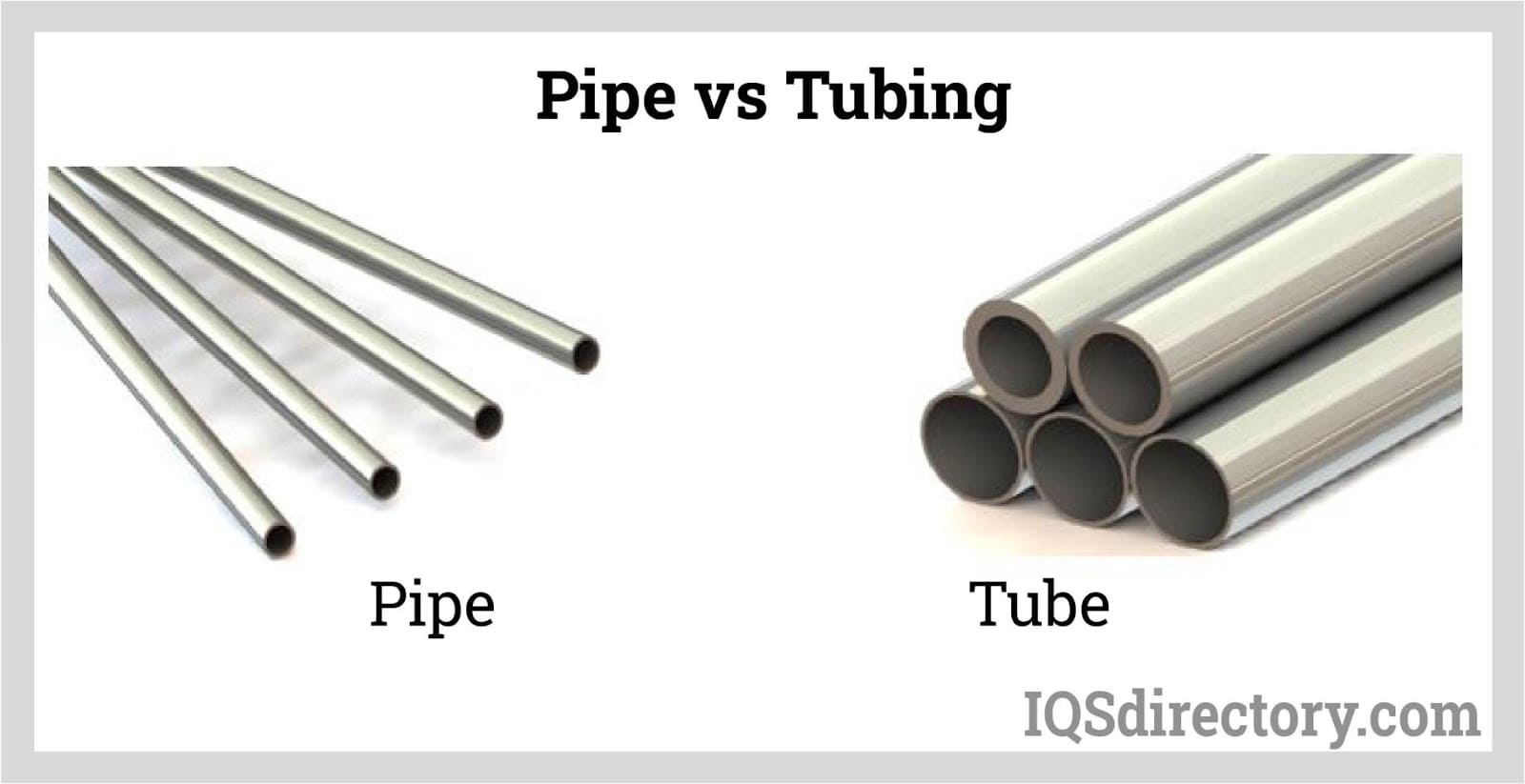 Since tubing is utilized in structural applications, the outer diameter is essential, with piping typically used to carry gasses or liquids capacity is critical.
Since tubing is utilized in structural applications, the outer diameter is essential, with piping typically used to carry gasses or liquids capacity is critical.
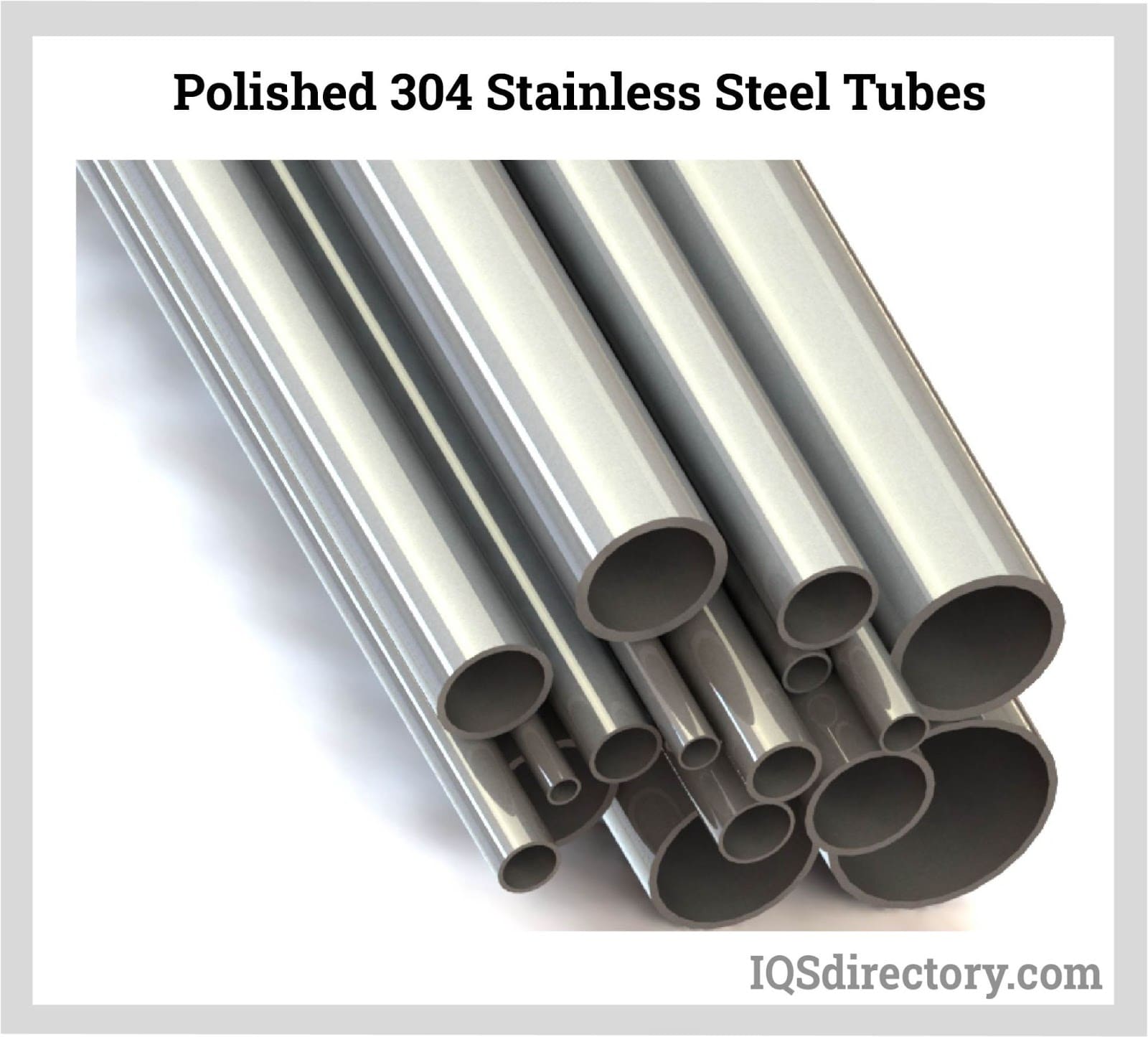 304 stainless steel tube are manufactured with carbon, iron, chromium concentration ranges from 18 to 20%, and nickel content ranges from 8 to 18%.
304 stainless steel tube are manufactured with carbon, iron, chromium concentration ranges from 18 to 20%, and nickel content ranges from 8 to 18%.
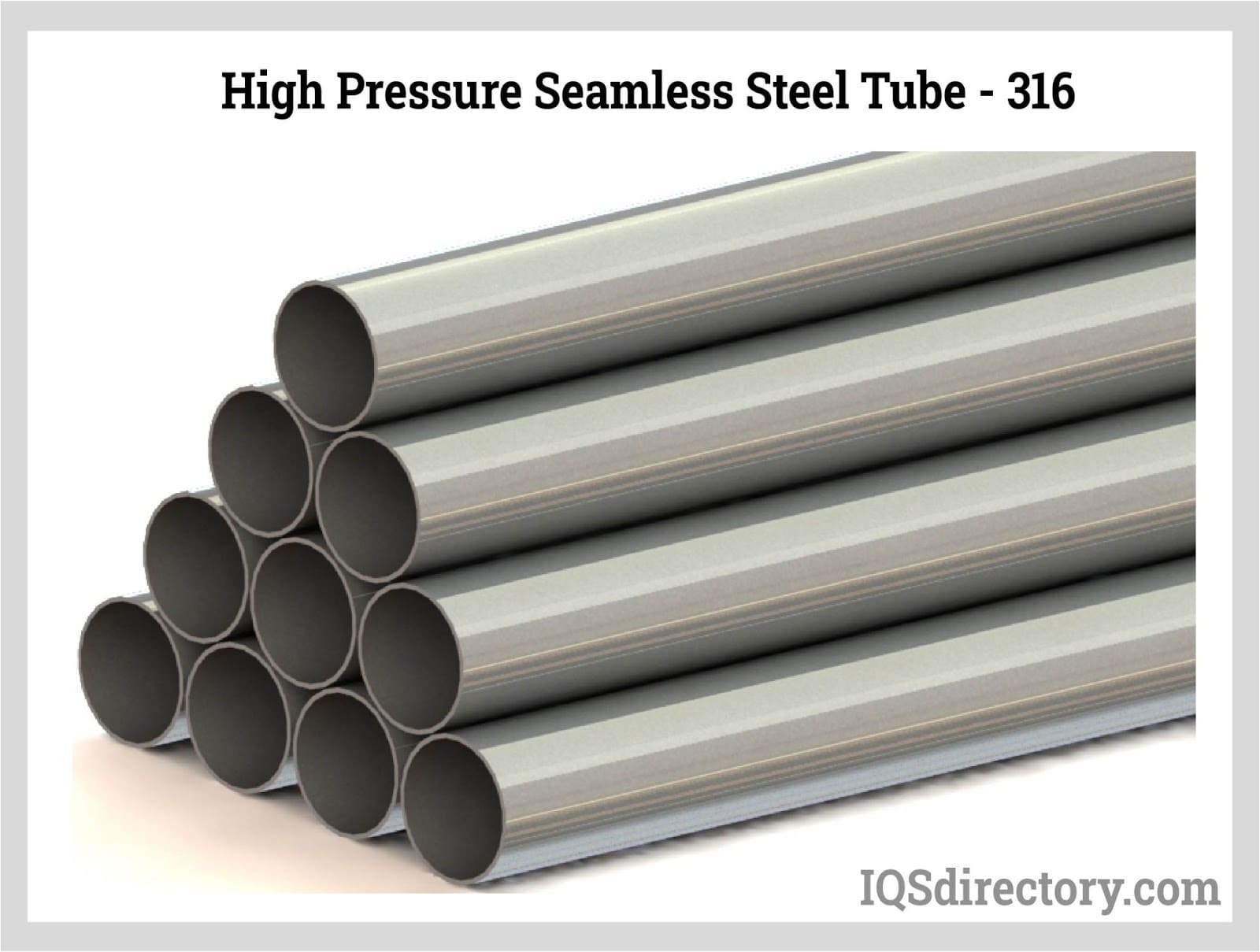 316 stainless steel tubes are manufactured with carbon and chromium levels of 10%.
316 stainless steel tubes are manufactured with carbon and chromium levels of 10%.
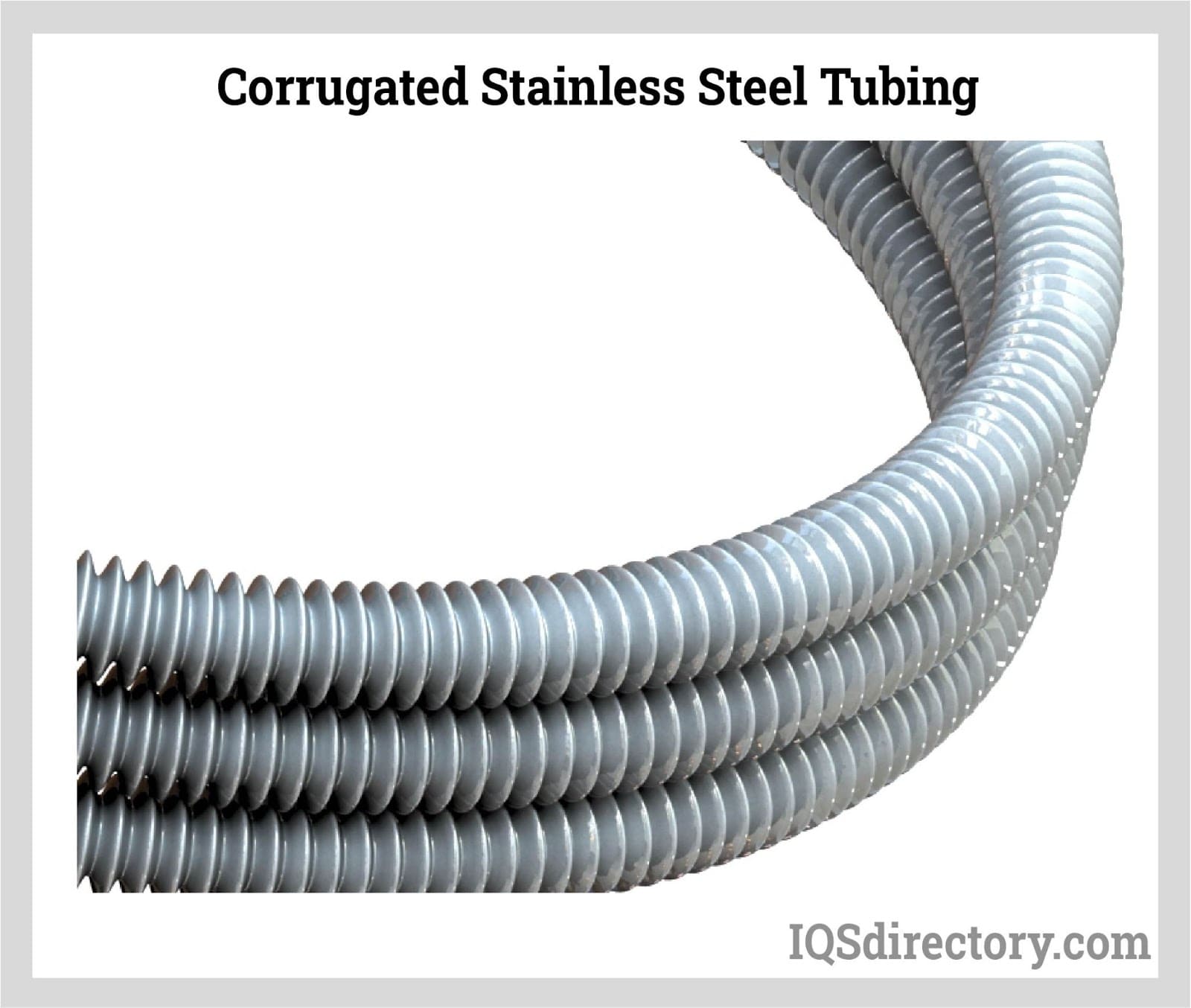 Corrugated stainless steel tube, a multi-layered hollow cylindrical object utilizing an alternative to typical steel piping as a medium for transporting gasses.
Corrugated stainless steel tube, a multi-layered hollow cylindrical object utilizing an alternative to typical steel piping as a medium for transporting gasses.
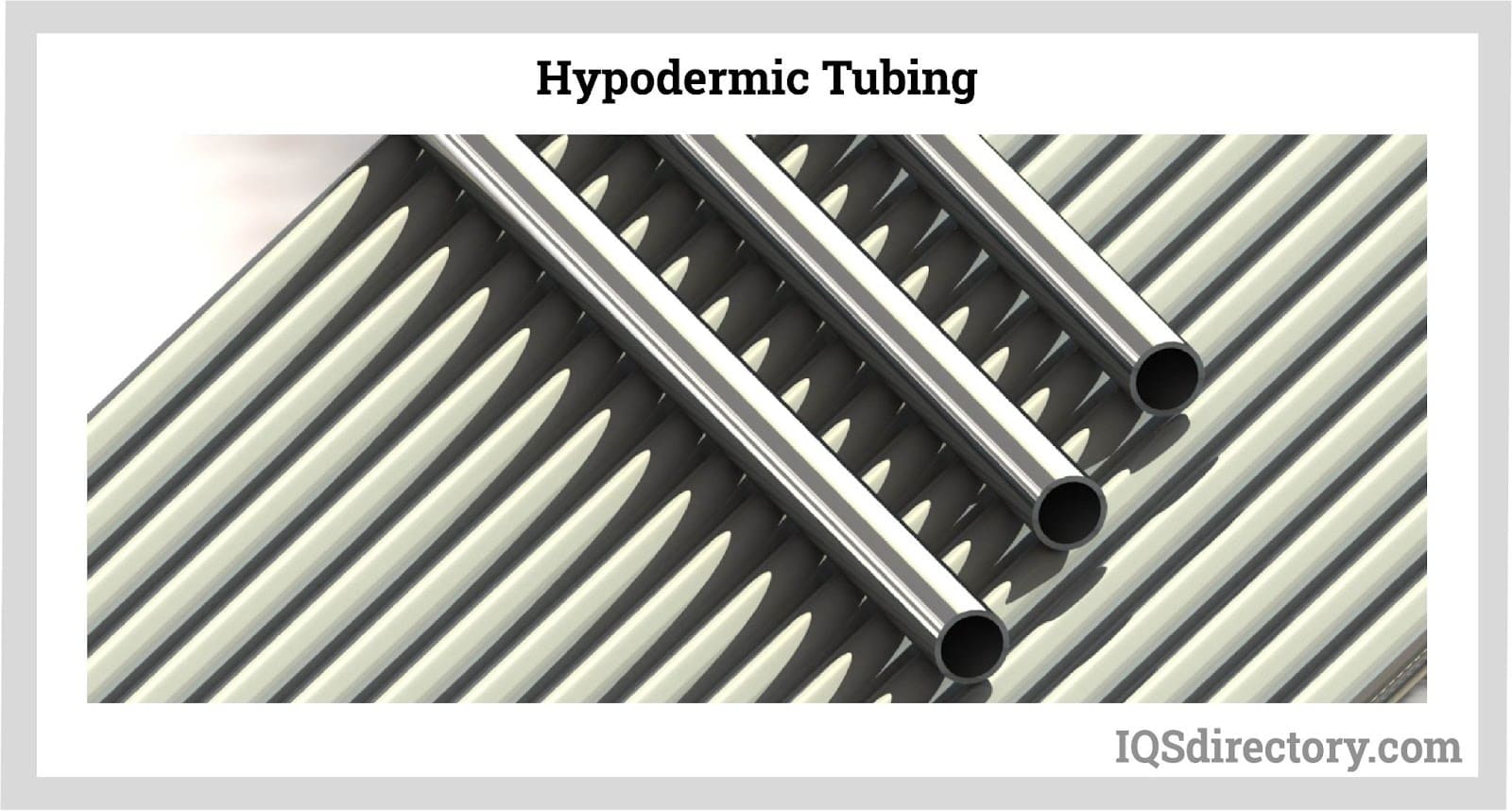 Hypodermic tubing, a typical medium for administering medicines under the skin.
Hypodermic tubing, a typical medium for administering medicines under the skin.
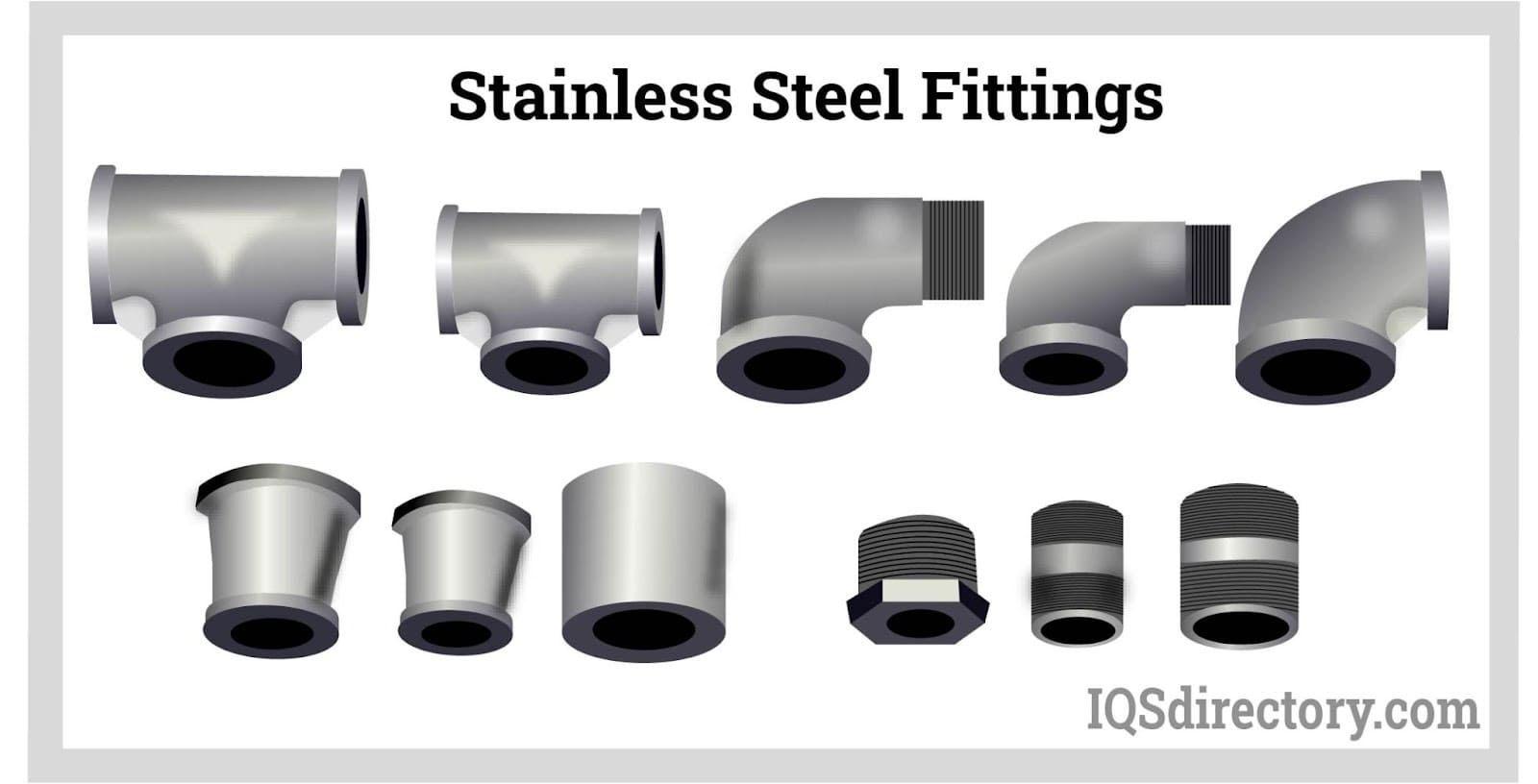 Stainless steel pipe fittings are used to join or close the ends of pipes and tubing to increase offset, in-line, mounting, and multiport possibilities.
Stainless steel pipe fittings are used to join or close the ends of pipes and tubing to increase offset, in-line, mounting, and multiport possibilities.
Types of Stainless Steel Tubing
There are many types of stainless steel tubing and there are many ways that one stainless steel tube varies from another stainless steel tube. For example, one stainless steel tube could have a different grade, could have seams or be seamless, have a different length, radius, or wall thickness, and be polished or unpolished.
- 304 Stainless Steel Tubing
- A hollow, cylindrical machine and piping component made of grade 304 stainless steel alloy and used most commonly to transport fluids and gases.
- 316 Stainless Steel Tubing
- A hollow, cylindrical machine and piping component made of grade 316 stainless steel alloy and used most commonly to transport fluids and gases.
- Corrugated Stainless Steel Tubing
- A multilayered hollow cylindrical object used as an alternative to traditional steel piping as the medium through which gases are transported.
- Hypodermic Needles
- Medical instruments that use stainless steel tubing to move fluids.
- Hypodermic Tubing
- A slender, hollow, cylindrical length of stainless steel, a puncturing point made at one end to form a needle which is commonly used as the medium for introducing medicine or drugs under skin.
- Medical Tubing
- Often made from stainless steel because of its hygienic nature. Medical tubing is also used in the production of instruments and implants for the medical industry.
- Nickel Tubing
- A common type of tubing. Nickel is often used in combination with copper in many applications, including those in the marine industry that involve moderate exposure to chlorine, to which nickel-copper alloys are resistant.
- Small Diameter Tubing
- Used in equipment found in medical and dental applications, including those used in minimally invasive procedures. Capillary tubing, for example, measures less than or equal to 0.188 inches in outside diameter.
- SS Tubes
- Hollow cylindrical objects, similar to pipes, used as the medium through which fluids and gases are transported as well as various other equipment components, such as hydraulic cylinders.
- Stainless Steel Bars
- Of different shapes are utilized in the construction and transportation industries because of the bars’ high strength and low maintenance requirements. Stainless bars and rods provide excellent structural support and reinforcement.
- Stainless Steel Pipes
- Used in applications involving corrosive fluids, high temperatures and high contaminant levels because of the great corrosion resistance of stainless steel pipes. Industries in which stainless steel pipes are popular include the oil/gas, pulp and paper and water/wastewater industries.
- Stainless Steel Pipe Fittings
- Attachments used to connect or close the end of pipes and tubing to increase in-line, offset, multiport and mounting capabilities.
- Stainless Steel Square Tubing
- A pipe-like hollow piece of hardware having four sides of equal length which is used in applications in which traditional round or oval stainless tubes are not acceptable.
- Stainless Steel Tubes
- Hollow cylinders made of stainless steel that are often used for the transportation of liquids and gases.
- Syringes
- Small, hollow tubes used for injecting or withdrawing fluids for medical purposes.
- Thin Wall Tubing
- Consists of extremely thin stainless tubing, the walls of which usually measure 0.12 inches or thinner. Despite its thinness, thin wall tubing still provides insulation and strength and is commonly used in medical and aerospace applications.
Stainless Steel Tubing Applications
As mentioned, stainless steel tubing has utility in many products and infrastructures from machines that are used daily in factories to car mufflers. In many applications, stainless steel tubing serves the same purpose. That purpose is to transport or regulate the transportation of either a gas or a liquid. The reason why stainless steel tubing lends itself to gases and liquids is that it can dependably support hot gases and corrosive liquids without degrading. Stainless steel is so great because its use is limited by imagination, creativity, and money.
Stainless steel tubing can be used anywhere and is limited by how much money is allotted to the tubing piece of the project. Stainless steel tubing can also be left in the outdoors for extended periods of time without rusting and falling apart. Because of stainless steel's ability to resist deterioration, many industries and products utilize stainless steel tubing. Stainless steel tubing is used in damp factories with concrete flooring, many hunting and outdoor products such as firearms and tents, kitchenware with stainless steel sanitary tubing, and in the automotive industry to manufacture automobiles.
Stainless Steel Tube Grades
There are several grades of stainless steel tubing which affects how corrosive resistant the tubing will be based on the percentages of each metal that makes up the alloy. The grades are 304, 304L, 316, 316L, and 430. For example, grade 304 is a basic chromium-nickel alloy and is highly malleable into different shapes while grade 430 is a chromium ferritic alloy that has lower corrosion resistance and is typically used for indoor products.
Seamless Tubing and Welded Tubing
As well as the grading, stainless steel tubing differs in the way that it is formed. For example, if tubing seamless is needed, then the seamless steel is extruded from a billet until the desired length, radius, and wall thickness is acquired. If a smaller radius is needed, then the tubing is rolled such that hypodermic tubing is created. When a company needs to create a lower pressure system, then electric resistance welded tubing can be used. Electric resistance welded tubing is created by fusing together smaller stainless steel pipe pieces into a longer tube using electric charge.
Polished Versus Unpolished Stainless Steel
As well, various finishes can be used on stainless steel. For example, unpolished stainless steels are very dull and used for applications that are not seen by many people. Polished stainless steels are treated with abrasives that range from low to high grit. While polished stainless steel has a pleasant aesthetic look, care should be taken because too much polishing could leave unwanted scrapes and signs of deterioration on the stainless steel.
Standards and Specifications of Steel Tubing
There are many standards in the stainless steel tubing industry set forth by ASTM International standards organization. ASTM ensures that proper standards are known across the world. Stainless steel tubing standards include the chemical composition (grades), fractional radii and wall thickness (mm), tube wall (in), weight (typically in lbs per ft), and working pressure (typically in psig) are all industry standards in stainless steel tubing.
Things to Consider When Purchasing Stainless Steel Tubing
There are many factors to think about when it comes to choosing the right manufacturer. Answering the following questions may help to choose the right manufacturer: What does the stainless steel tubing need to be able to do? How much money is budgeted toward the stainless steel tubing? Does the manufacturer adhere to industry standards? What do recent and past clients have to say about the manufacturing quality? Does the manufacturer offer custom stainless steel?
Hopefully this article offers a helpful overview of stainless steel tubing. There are many ways that one piece of stainless steel tubing can differ from another piece. More detailed information can be found on manufacturer's sites.
Proper Care for Stainless Steel Tubing
Since the protective chromium oxide layer requires chromium to react with the oxygen in the air, any dirt or unwanted doping can occur. Unwanted dirt and scum that resides on the surface of the stainless steel tubing can act as a trap for corrosive or harmful materials. Therefore, stainless steel does require regular and varying levels of maintenance and care depending on the grade stainless steel. For example, proper care for smudges and fingerprints differs from the proper care for corrosive material getting stuck to the surface of the stainless steel. For smudges and fingerprints, sodium carbonate and glass cleaner is routinely used. Hot water and soap must be the last chemicals to touch the stainless steel before finishing the cleaning process.
If sodium carbonate and glass cleaner do not clean the oils or trapped dirt, then solvent cleaning can be used. Non abrasive detergents and solvents that are low in chloride concentration can be used to clean stainless steel tubing. Lastly, there is ultra-high purity tubing, chemically cleaned tubing, and thermocouple cleaned tubing. Ultra-high purity tubing is usually electro-polished inside and does not gather much dirt. Chemically cleaned tubing and thermocouple cleaned tubing allow stainless steel tubing to meet the highest of cleanliness standards.
Stainless Steel Tubing Accessories
To accompany stainless steel tubing, there are tube fittings, valves, regulators, tube benders, and tube cutters. Tube fittings and adapters can be used to connect stainless steel tubes. Different fittings and adapters are rated for high and low pressure levels as well as temperatures and varying wall thickness. Valve accessories are the same way. Valves and end connections are rated in the same way for pressures and temperature levels. Regulators are used to vary the pressure and flow of the material flowing through the stainless steel tubing. Like valves and fittings, regulators are rated for high and low temperatures and pressures. Tube benders come in hand-held single tube benders. However, if needed, hydraulic tube benders are made that can reliably and more efficiently bend multiple tubes at a time.
Stainless Steel Tubing Terms
- Annealing
- Reducing hardness and stress in a metal, such as stainless steel, through heating and cooling applications.
- Bright Annealing
- A form of annealing in which the level of atmospheric gas is reduced in order to remove surface oxides from the surface of the stainless steel and to prevent discoloration during the annealing process. This process is responsible for the bright, shiny appearance associated with stainless steel.
- Burst Pressure
- The internal pressure limit of stainless steel tubing at which point the tube material will expand to the point of deformation or bursting.
- Cold Drawing
- A cold forming process, commonly used in tube and pipe diameter reduction, in which a tube is drawn through a carbide die. The diameter of the emerging stainless steel tube or stainless steel pipe reflects the size of the die.
- Concentricity
- A characteristic of a welded stainless steel tubing in which wall thickness remains consistent throughout the stainless steel tubing, and the inside and outside diameter centers are equivalent to one another.
- Corrosion
- The decay of metals by chemical agents, which convert them to nonmetallic products. Stainless steel has a passive film created by the presence of chromium and often other alloying elements, such as nickel and molybdenum, that resists this process.
- Degree of Bend
- The depth of bend or the sweep of the arc. The minimum degree of bend is about five degrees, while the maximum degree of bend in rotary-draw bending is 180 degrees.
- Destructive Testing
- The testing of stainless steel tubing properties, such as tensile strength, yield strength, hardness, burst pressure and bending.
- Eccentricity
- A characteristic of seamless tubing in which wall thickness is not consistent throughout the tube.
- Hardness
- A characteristic of tubular products that is measured on samples of tubing using a standard Rockwell Penetrator and recording the results on the Rockwell "B" scale. Hardness is the direct result of annealing temperatures and material properties; in general, as the hardness number increases, both tensile and yield strengths increase along with a corresponding decrease in elongation (ductility).
- Hydrostatic Testing
- A test in which water is introduced into the stainless steel tubing at high pressure levels in order to test for holes and porous parts. Because hydrostatic testing is a nondestructive test, the water pressure level does not surpass the stainless steel tubing yield strength.
- I.D. (Inside Diameter)
- A term that refers to the diameter of the interior portion of stainless steel tubing and pipes. The measurement of the stainless steel tube or stainless steel pipe is not included in I.D.
- IPS
- A pipe specification system that associates certain nominal pipe diameters with standardized wall thickness called “schedules.” The same schedule number will have a different fixed decimal inch value for each nominal diameter.
- O.D. (Outside Diameter)
- A term that refers to the diameter of the exterior portion of stainless steel tubing and pipes. The tube or pipe is included in the O.D. measurement.
- Ovality
- A quantitative measurement of how "round" a tube is, which is derived by comparing width to height. Limits of ovality are specified on the appropriate ASTM specification of a product.
- Passivation
- The creation of a passive oxide layer on stainless steel, which is responsible for the high corrosion resistance of stainless steel used in stainless steel tubing.
- Residuals
- The impurities remaining in mini-mill stainless steels, which result from the wide variety of metals entering the process.
- Seamless Tubing
- The creation of stainless steel tubing through the use of a piercing mill. During the process, a round blank is pierced to produce the stainless steel tubing, which produces inconsistency in wall thickness throughout the tube that can be fixed through secondary operations.
- Welded Tubing
- The creation of stainless tubes through roll forming and fusing the stainless steel along a seam. Welding provides consistency throughout the stainless steel tubing.